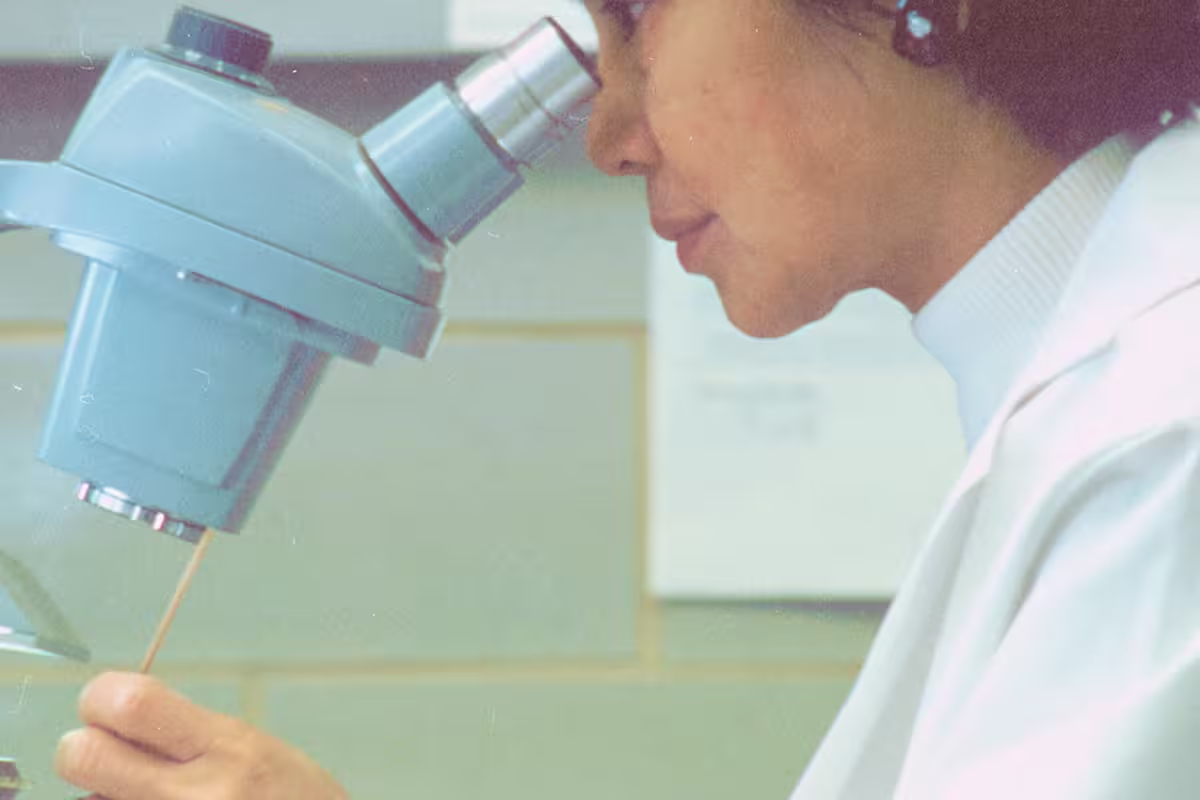
.avif)
Bacterial Vaginosis (BV) vs Yeast Infection: Key Differences
Compare BV vs yeast infection by discharge, odor, pH, and treatments to determine which you have and get the right relief quickly.
Words by Olivia Cassano
Scientifically edited by Dana Alloy
Medically reviewed by Dr. Christine Vo, MD
Bacterial vaginosis (BV) and yeast infections are two very common vaginal infections. Up to 75% of women will have a vaginal yeast infection at least once in their lifetime, and one in three people with vaginas will get BV each year.
As you likely know from having one or the other (or both), BV and yeast infections can cause a host of symptoms, including pain, itching, and abnormal discharge or smell.
Not only are they both irritating and frustrating issues, but it can be tricky to tell them apart. Especially given that most sex-ed is subpar, many people with vaginas never learned the difference in the first place!
Being misdiagnosed actually happens more often than being correctly diagnosed. In a study of 220 symptomatic patients, 61% of BV and 77% of yeast infection diagnoses were incorrect. We aren’t much better at diagnosing ourselves, either. One study showed self-diagnoses of BV were correct only 56% of the time, while 69% of those who thought they had a yeast infection actually had something else. Another article showed that only about a third of individuals were correct in diagnosing themselves with a yeast infection.
However, the causes, symptoms, and treatments for BV and yeast infections have some telltale differences. Keep reading to learn more about the key differences between BV vs yeast infections, and tips to prevent both.

Recurrent symptoms? Get Evvy's at-home vaginal microbiome test, designed by leading OB-GYNs.
Causes of BV and yeast infections
BV and yeast infections are both caused by an overgrowth of microbes in your vaginal microbiome, leading to vaginitis, but the main difference between BV and yeast infections is what kind of microbe is responsible for the infection.
BV is an umbrella term for an infection caused by harmful bacteria, while a yeast infection is caused by various types of Candida, which are fungi. Most yeast infections are caused by the overgrowth of Candida albicans, specifically.
Possible triggers for BV
In a healthy vaginal microbiome, protective bacteria (namely, Lactobacilli) stop harmful bacteria from taking over. However, sometimes they fall short, and bad bacteria (like Gardnerella vaginalis bacteria) take hold. When this happens, it can lead to BV. Some possible risk factors and triggers for BV are:
- Sex (especially with new or multiple sexual partners)
- Hormonal fluctuations (e.g, birth control, pregnancy, and menopause)
- Your period
- Smoking
- Stress
- Douching.
Possible triggers for yeast infections
When it comes to yeast, most people already have a small amount in their bodies (including the vagina) without it causing any issues. However, when levels of yeast increase beyond a healthy amount, it can lead to a yeast infection. Possible risk factors and triggers for yeast infections include:
- Antibiotics
- Sex
- Birth control, specifically oral contraception and IUDs
- Your menstrual cycle
- Hormonal changes, such as pregnancy or the use of hormone replacement therapy
- A weakened immune system
- Diabetes.
Symptoms comparison: discharge, odor, and irritation
Bacterial vaginosis and yeast infections share some overlapping symptoms but have key differences. One of the biggest clues is the vaginal discharge. BV typically causes thin, watery, gray or white discharge with a distinctive fishy odor, especially after sex. In contrast, yeast infections often cause thick, white, clumpy discharge with no smell, often described as resembling cottage cheese.
BV may come with mild itching or irritation, but not always. Yeast infections, on the other hand, usually cause intense itching, redness, swelling, and burning during urination or sex.
.jpg)
How do I know if I have BV or a yeast infection?
BV and yeast infections sometimes present very differently. For example, a strong fishy smell is exclusively a BV symptom, while white, clumpy discharge is the hallmark symptom of a yeast infection.
However, both conditions can produce symptoms that are a bit ambiguous — BV may be asymptomatic, and yeast infections may be more irritating than they are visually apparent. Here are the full lists of symptoms to help distinguish between the two:
BV symptoms
Common symptoms of BV include:
- White or grey vaginal discharge that is thin and watery
- A strong or fishy odor (that becomes stronger after sex).
- In some cases, BV can also cause pain, discomfort, or burning during sex and when peeing.
That said, you can develop BV and have no obvious symptoms. Up to 84% of those with BV are asymptomatic. While some may feel blessed to do without the unwanted vaginal discharge, this is concerning because BV can increase the risk of other health issues, such as:
- Sexually transmitted infections (STIs) like chlamydia, gonorrhea, trichomoniasis, herpes, HPV, and HIV
- Pelvic inflammatory disease (PID)
- Fertility issues and failed IVF
- Pregnancy complications
- Gynecological cancers such as ovarian, cervical, or endometrial cancer
- Cervicitis
- Toxic shock syndrome (TSS).
Yeast infection symptoms
Common symptoms of a yeast infection are:
- Lumpy, white, cottage cheese-like vaginal discharge
- Itching or burning around the vulva and vagina
- Pain or discomfort during sex
- A burning sensation when you pee.
If you’re not totally sure whether you have BV or a yeast infection, it’s best to check in with your OB-GYN or general healthcare provider. Your provider may perform a pelvic exam to obtain a sample by swabbing the vaginal wall and discharge to help make the diagnosis.
It is important to note that both of these vaginal infections also share symptoms with STIs like trichomoniasis and chlamydia. As STIs can lead to long-term consequences, it is best to check with a doctor ASAP if this could also be a possibility.
Treatment for BV and yeast infections
Since yeast infections and BV are caused by different microbes, they’re treated by different types of medication.
BV is treated with prescription antibiotics that can either be taken orally or vaginally. The most common antibiotics used to treat BV are metronidazole, clindamycin, and tinidazole.
Yeast infections are treated with prescription or over-the-counter (OTC) antifungal medications called azole antifungals (like clotrimazole, miconazole, and terconazole), which can also be either oral or vaginal treatments.
Both BV and yeast infections have an annoying habit of resisting treatment or coming back. Researchers are still trying to find effective, long-term treatment options for recurrent vaginal infections, so prevention is key.
How to prevent BV and yeast infections from coming back
One way to support your vaginal microbiome is by taking a probiotic supplement. But not all probiotics are created equal — many don’t even contain the strains of bacteria naturally found in the vagina. While the idea of replenishing protective bacteria is promising, the probiotic you choose must be specifically designed for vaginal health and clinically proven to be effective. Evvy Women's Complete Probiotic includes Lactobacillus strains clinically proven to support the natural balance of bacteria and yeast in the vaginal microbiome.
Boric acid is a commonly used treatment for vaginal issues. Boric acid is not considered a first-line treatment for vaginal infections, but it can be helpful in certain cases. It can be used to treat yeast infections caused by non-albicans strains like Candida glabrata, or when standard antifungal treatments have failed. In the case of BV, boric acid is sometimes used as part of a long-term maintenance plan for those with repeat infections. While research is limited on its effectiveness in treating BV directly, boric acid may help by breaking down bacterial biofilms and restoring vaginal acidity, making the environment less favorable for harmful microbes.
Above all, avoiding things that can disrupt your vaginal microbiome or irritate your vagina is the best way to keep your vagina healthy. To reduce your chances of getting BV or yeast infections, try to maintain healthy habits such as:
- Practicing safe sex (use condoms and dental dams, wash sex toys after each use, etc.)
- Avoiding douching and using feminine hygiene washes or scented soaps
- Change your period products within the proper time frame
- Stick to underwear that is loose-fitting, lightweight, breathable, and made from a natural fabric, and change it often.
Get care for BV and yeast infections with Evvy
If you’re experiencing recurrent bacterial vaginosis, yeast infections, or ongoing vaginal symptoms, testing with Evvy over time can help you identify potential triggers and patterns. After taking an Evvy vaginal microbiome test, a licensed provider can review your results and provide a clinical diagnosis for conditions like BV or yeast infections. For eligible users, the provider may also prescribe custom treatment tailored to your unique microbiome.
Evvy offers the first-ever platform for vaginal healthcare that combines advanced microbiome testing, personalized prescription treatments, and 1:1 coaching. Built with leading OB-GYNs and researchers, our care model ensures you're connected with providers who specialize in interpreting vaginal microbiome results and delivering targeted care. They can also recommend research-backed supplements, like the Evvy Women's Complete Probiotic, to help restore your microbiome to a more protective state.
FAQ
How do I know if I have a yeast infection or BV?
Figuring out if you have a yeast infection or bacterial vaginosis (BV) can be a bit tricky since both can cause uncomfortable symptoms, but there are some key differences to look out for. If you have a yeast infection, you’re likely to notice thick, white discharge that looks a bit like cottage cheese, along with intense itching and irritation. On the other hand, BV typically causes a thin, gray discharge with a strong, fishy odor, but doesn’t typically cause itching. If you're unsure or if the symptoms are new to you, it's always a good idea to check in with your healthcare provider — they can help you get the right diagnosis and treatment. Alternatively, you can take an Evvy Vaginal Health Test to get to the bottom of your symptoms.
Can BV and yeast infections occur at the same time?
Yes, it’s possible to have BV and a yeast infection at the same time. This is called a co-infection, and it can make symptoms like discharge, itching, and irritation more intense or confusing. Because BV and yeast infections require different treatments (antibiotics for BV and antifungals for yeast), it’s important to get tested so you receive the right care for both if needed.
Which is more serious: BV or a yeast infection?
Neither condition is typically dangerous on its own, but BV can lead to more serious complications if left untreated, especially in pregnancy or before certain medical procedures. It’s also been linked to an increased risk of STIs. Yeast infections, while uncomfortable, are usually easier to treat and less likely to cause complications. That said, recurrent vaginal infections of any kind deserve attention and proper care.
Does bacterial vaginosis itch?
On paper, bacterial vaginosis doesn’t usually cause any itching, but it can. Although the research doesn’t associate vaginal itching as a symptom of BV, many women experience it as a symptom. It’s hard to say if it is a direct cause of the BV itself or because BV causes inflammation, which can manifest in itching.





